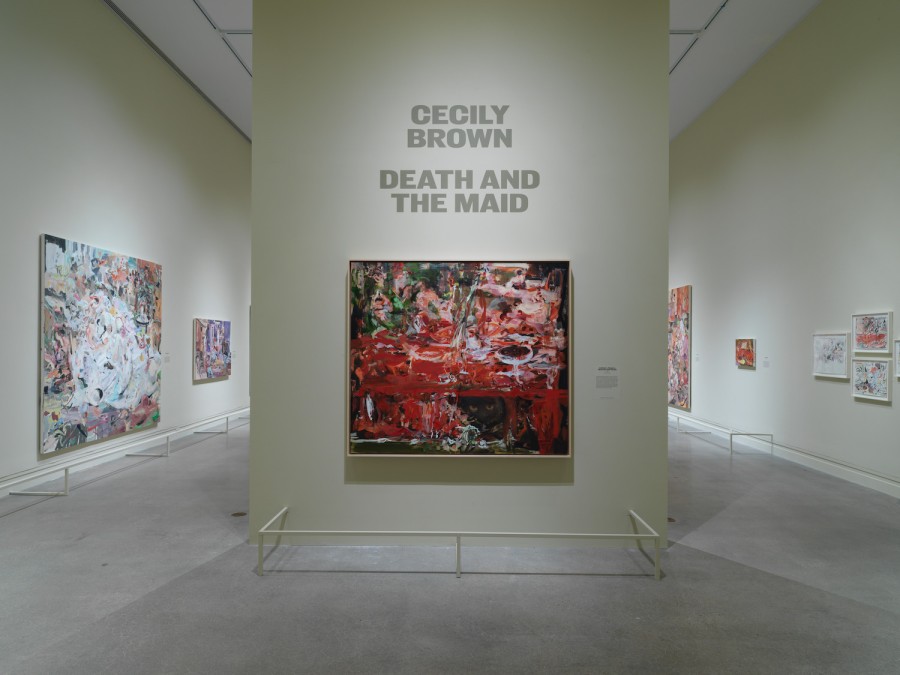Review: ‘Death and the Maid’ breathes color into mundane inevitabilities
Cecily Brown’s solo exhibition can be viewed at the Metropolitan Museum of Art until Dec. 3.
“Lobster, Oysters, Cherries and Pearls” by Cecily Brown is on view until Dec. 3 at the Metropolitan Museum of Art. (Photo by Paul Lachenauer, courtesy of the Metropolitan Museum of Art)
April 26, 2023
It is hard to miss the Cecily Brown exhibition at the Metropolitan Museum of Art; its advertising banner creates a stark contrast of color on the colossal and ornate building on Fifth Avenue. Set atop the beige architecture of the institution, a giant poster reads “CECILY BROWN DEATH AND THE MAID.” The text is laid over the artist’s 2021 painting “Maid in a Landscape,” which shows an abstract landscape, and a female figure interacting with a skeleton through colorful and casually oriented brush strokes. The poster sets the tone for the dynamic excitement inside the museum’s Modern and Contemporary Art wing.
“Death and the Maid” is the “first full-breadth exhibition of Brown’s work in New York,” where the London-born artist has resided for 30 years. With works selected by modern and contemporary art curator Ian Alteveer, the show includes around 50 pieces of Brown’s work. Although her paintings are the show’s main attraction, viewers also get to peek into the artist’s brain, seen through her drawings and sketchbooks.
The internationally-acclaimed artist rose to fame in the late 1990s after graduating from the Slade School of Fine Art in London and moving to New York City. Brown’s work quickly became popular and had a high market value, with some pieces selling at over 3 million pounds before the end of the decade, according to the auction house Christie’s records.
Brown tends to focus on subjects that are championed as Western art history’s most prominent themes, with “vanity and vanitas” and the still life form being highlighted by the exhibition. In her works, Brown takes inspiration from other successful artists such as Édouard Manet, Edvard Munch and Jackson Pollock.
The exhibition — tucked away in a long gallery towards the back of the museum — begins on one side with Brown’s large 2020 oil painting “Lobster, Oysters, Cherries and Pearls.” The primarily red and pink abstract piece has some hints of realism. According to the painting’s label, the subject matter of the piece represents “a number of luxuries pictured in the seventeenth century — Dutch and Flemish still lifes.” A black cat with big, bright eyes peeks out from the red brush strokes and looks intently at the viewer.
The large 2020 oil painting “Selfie” hangs on the wall across from “Lobsters, Oysters, Cherries and Pearls.” The piece features Brown’s signature abstract brush strokes and thick paint in many colors, with some realistically painted details. The bottom of the painting is primarily pastel red, pink, and cream and shows what seems to be a person lying across a surface. Above in cooler blues, yellows and greens, the paintings depicts a gallery wall of assorted images. All of Brown’s work creates an immersive experience — every second spent looking at her work is filled with the discovery of more detail. “Selfie” is one of the pieces that exemplifies this principle best.
Brown’s perception of the world is particularly astute, especially when focused on the exhibition’s themes of vanity and death. One of the more common motifs in the show is a woman looking in the mirror. The viewer is somewhat of a voyeur while looking at these images, as we look in on the private act of others’ self-understanding.
“Vanity Shipwreck” is a primarily blue painting. A woman sits at a vanity table staring out into the void, surrounded by chaotic brush strokes meant to represent her life. In “The Only Game in Town,” hints of a scene emerge from the yellow canvas: a thinly outlined woman staring at herself, and a messily abstract, red face stares back. It is clear that the focus on vanity is one of understanding and acceptance. “Aujourd’hui Rose” shows two women looking at each other, barely discernible due to the muted tones employed. By contrast, her “Untitled” sketches — inspired by Manet and Jean-Honoré Fragonard — at the center of the gallery show women staring at themselves in a meticulously detailed and vivid manner. Whether lost in her own thoughts or caught up in a moment, this fascination with exploring what it means to be a woman runs through Brown’s work.
While many look at vanity as a shallow characteristic, Brown presents it as something that should be accepted as normal. We all stare at ourselves — Brown makes us acutely aware of this — and to put it on display in this nonchalant fashion is perhaps an acceptance of the inevitability of what it means to be a human, always caught thinking about one’s self in one capacity or another. This is especially true today, when so much emphasis is placed on our exterior selves.
Centering ourselves as subjects to be viewed from the outside gives us a sense of understanding our own consciousness. Our existence is accepted, our identities corroborated by our tangible presence in the mirror.
Brown also focuses on the opposite of life at its most overblown, presenting the act of dying as a natural occurrence not to be feared. Whether in the painting, “Maid in a Landscape,” or in the skull of “Aujourd’hui Rose,” Brown’s technique presents death in a graceful manner. She opposes somber representations of the subject matter by employing an excessive, and ebullient, use of color. If we cannot avoid self-obsession and death, shouldn’t they at least be represented in an acceptable, and perhaps even beautiful, manner?
Brown is a master of the brush, and that has never been more clear than in this comprehensive show. While you may be there for hours dissecting just one piece, there is much to be learned. Look for the colorful in the mundane and inevitable aspects of being human.
Contact Alexa Donavan at [email protected].

























































































































































